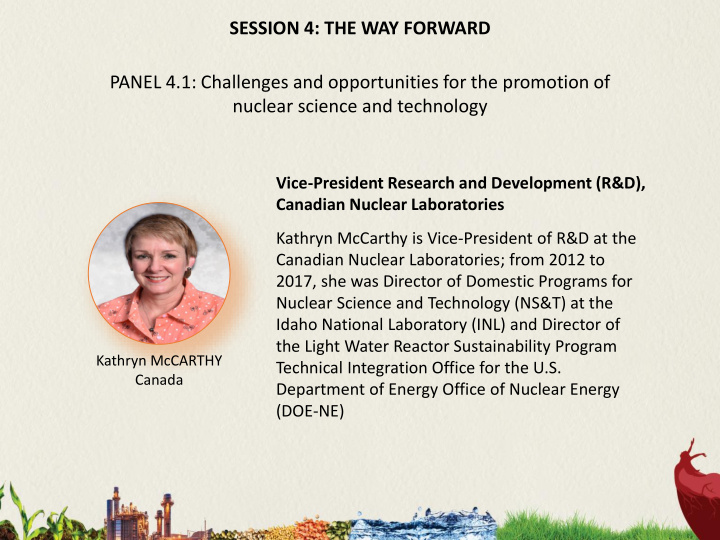



SESSION 4: THE WAY FORWARD PANEL 4.1: Challenges and opportunities for the promotion of nuclear science and technology Vice-President Research and Development (R&D), Canadian Nuclear Laboratories Kathryn McCarthy is Vice-President of R&D at the Canadian Nuclear Laboratories; from 2012 to 2017, she was Director of Domestic Programs for Nuclear Science and Technology (NS&T) at the Idaho National Laboratory (INL) and Director of the Light Water Reactor Sustainability Program Kathryn McCARTHY Technical Integration Office for the U.S. Canada Department of Energy Office of Nuclear Energy (DOE-NE)
Canadian Nuclear Laboratories – Past, Present, and Future Kathryn A. McCarthy, Laboratory Director & Vice-President, R&D IAEA, 2018 November 30 UNRESTRICTED -2-
AECL* Then and Now • Established as a Canadian federal Crown corporation in the 1950s • Historically 2 main areas of focus: • Design, sale, service of CANDU reactors (commercial business) • Nuclear laboratories (science and technology services for public good and nuclear industry) • Government decision to restructure the organization to reduce risks and costs to Canadian taxpayers • 2011: Phase I of the restructuring completed with the divestiture of the CANDU Reactor Division (sold to Candu Energy Inc., a subsidiary of SNC-Lavalin). • 2015: Phase II completed with the implementation of a Government-owned, Contractor- operated (GoCo) model at the nuclear laboratories *AECL: Atomic Energy of Canada Limited UNRESTRICTED -3-
The Chalk River Laboratories is the single largest Canadian Nuclear Laboratories is the single largest science and technology laboratory in Canada. science and technology laboratory in Canada Vision 9,100 acres with 200 acres of lab complex 17 nuclear facilities, 70 major buildings Canadian Nuclear Laboratories is a world-class, sustainable national nuclear 3,100 employees (500 PhDs & Masters) laboratory delivering science and 1,600 engineering, scientific & technical staff technology structured to meet current, and adapt to changing, Canadian federal, global commercial, and public priorities in four program areas: Energy, Health, Environment, and Safety & Security
Energy Utilities, Advanced Reactors, Fuel Development • ➢ Develop new carbon-free energy generating technologies ➢ Improve the safety, longevity, and performance of existing technologies • Examples of Projects • Feasibility and benefits of advanced nuclear reactor hybrid energy systems • Understanding the degradation of concrete • Development of an integrated copper-chlorine cycle for efficient hydrogen production from nuclear and renewable energy sources
Environment Environmental Monitoring and Remediation • • Reduce the impact of radioactive material to the environment ➢ Understand the effects of radiation on the environment ➢ Promote a clean, healthy environment by addressing legacy liabilities ➢ Demonstrate methods for the safe storage and management of nuclear waste • Examples of Projects • Radon ventilation • Polonium-210 in the aquatic environment • Emerging environmental issues regarding NORM (naturally occurring radioactive materials) in industries not associated with the nuclear fuel cycle in Canada
Health Radiological Services • ➢ Understand the effects of radiation on living things ➢ Research and develop medical applications for nuclear science ➢ Bioassay services, dosimetry experiments, alpha isotope expertise & licensing • Examples of Projects • Biological effects and mechanisms of low dose radiation on cataracts • Determine effects of chronic low-dose radiation exposure • Combined immune checkpoint therapy and low dose radiation for cancer treatments
Safety & Security Non-Proliferation, Counter-Terrorism, Nuclear Response and Emergency • Preparedness ➢ Develop monitoring, security and safeguards, and nuclear forensics technologies ➢ Find ways to prevent nuclear accidents, while improving ability to respond if they do occur • Examples of Projects • Radiological and nuclear techniques for detection and attribution of opioids and explosives • Active interrogation techniques for detection and characterization of special nuclear material • Tools and techniques to improve cyber and physical security of critical infrastructure
Kathy McCarthy Vice-President, R&D kathryn.mccarthy@cnl.ca www.cnl.ca
Recommend
More recommend